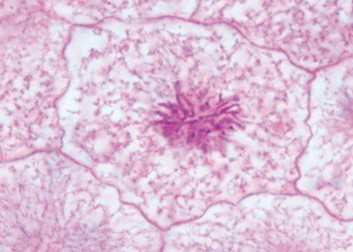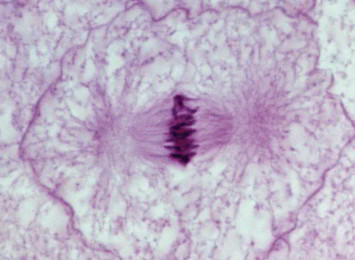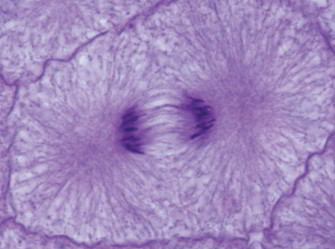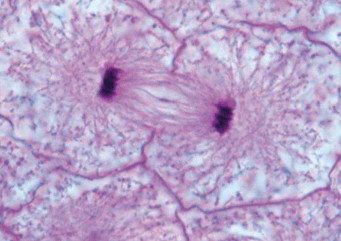Cells replicate themselves through a process called cell division. Two types of cell division occur in the body: mitotic cell division and meiotic cell division. Somatic cells (cells other than sex cells) divide by mitotic cell division, during which a parent cell divides to form two new daughter cells that have the same number (46) and composition of chromosomes as the parent cell. It enables growth and the repair of tissues. Meiotic cell division occurs only in the production of ova and sperm. In meiosis, a single parent cell divides to form four daughter cells that contain only half the number of chromosomes (23) found in the parent cell.
Mitotic Cell Division Starts with the first division of the fertilized egg, mitotic cell division is the process that produces new cells for growth of the new individual and the replacement of worn or damaged cells. Mitotic cell division occurs at different rates in different kinds of cells. For example, epithelial cells undergo almost continuous division but muscle cells lose the ability to divide as they mature. Three processes are involved in mitotic cell division:
- replication (production of exact copies) of chromosomes,
- mitosis, and
- division of the cytoplasm.
In dividing cells, the time period from the separation of daughter cells of one division to the separation of daughter cells of the next division is called the cell cycle. Mitosis constitutes only 5% to 10% of the cell cycle. Most of the time, a cell merely is carrying out its normal functions.
Interphase is defined as the phase when the cell is not involved in mitosis. When viewed with a microscope, a cell in interphase is identified by its intact nucleus containing chromatin granules. In cells that are destined to divide, both the centrioles and chromosomes replicate during interphase, while other organelles are synthesized and assembled. There is a growth period before and after replication of the 46 chromosomes.
A chromosome consists of a very long DNA molecule coated with proteins. During interphase, chromosomes are uncoiled and resemble very thin threads within the cell nucleus. Chromosomes replicate during interphase in order to provide one copy of each chromosome for each of the two daughter cells that will be formed by mitotic cell division. Chromosome replication is dependent upon the replication of the DNA molecule in each chromosome. Figure 3.18illustrates the process of DNA replication.
The two original DNA strands “unzip,” and new nucleotides are joined in a complementary manner by their bases to the bases of the separated DNA strands. When the new nucleotides are in place and joined together, each new DNA molecule consists of one “new” strand of nucleotides joined to one “old” strand of nucleotides. In this way, a DNA molecule is precisely replicated so that both new DNA molecules are identical.
Mitotic Phases
Once it begins, mitosis is a continuous process that is arbitrarily divided into four sequential phases: prophase, metaphase, anaphase, and telophase. Each phase is characterized by specific events that occur.
Prophase
During prophase , the replicated chromosomes coil, appearing first as threadlike structures and finally shortening sufficiently to become rod-shaped. Each replicated chromosome consists of two chromatids joined at their centromeres. Simultaneously, the nuclear envelope gradually disappears, and each pair of centrioles migrate toward opposite ends of the cell. A spindle is formed between the migrating centrioles. The spindle consists of spindle fibers that are formed of microtubules.
Metaphase
During the brief metaphase, the replicated chromosomes line up at the equator of the spindle. The centromeres are attached to spindle fibers.
Anaphase
During anaphase , separation of the centromeres results in the separation of the paired chromatids. The members of each pair are pulled by spindle fibers towards opposite sides of the cell. The separated chromatids are now called chromosomes, and each new set of chromosomes is identical.
Telophase
During telophase, the spindle fibers disassemble and a new nuclear envelope starts forming around each set of chromosomes as the new nuclei begin to take shape. The chromosomes start to uncoil, and they will ultimately become visible only as chromatin granules. The new daughter nuclei are completely formed by the end of telophase. Usually during late anaphase and telophase, the most obvious change is the division of the cytoplasm, which is called cytokinesis. It is characterized by a furrow that forms in the plasma membrane across the equator of the spindle and deepens until the parent cell is separated into two daughter cells. The formation of two daughter cells, each having identical chromosomes in the nuclei, marks the end of mitotic cell division.





 (57 votes, average: 4.53 out of 5)
(57 votes, average: 4.53 out of 5)